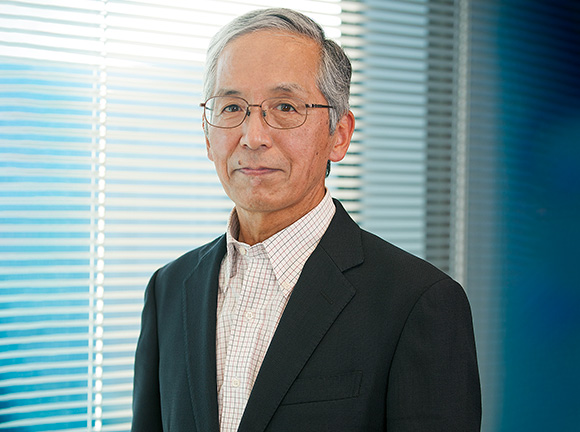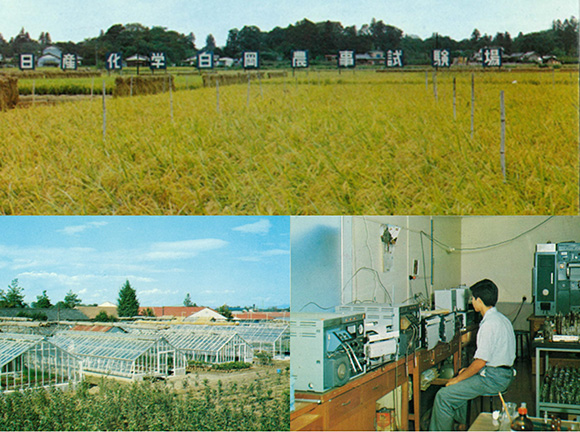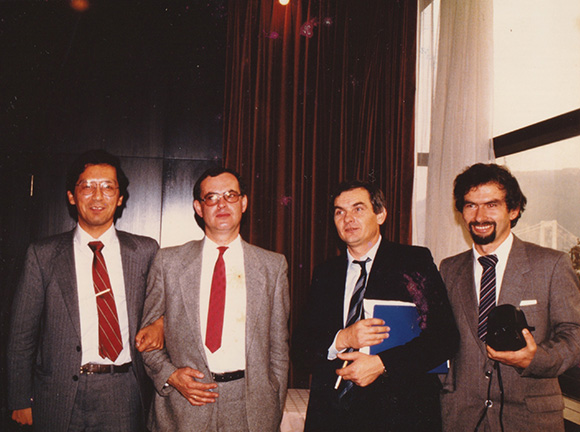FORMER RESEARCHER TALKS
ABOUT TARGA
TARGA was developed 40 years ago
and is still very useful in many farms all around world.
I am proud to be part of this research.
Today, Nissan Chemical is constantly researching and developing agrochemicals and owns a number of its own proprietary molecules. However, in the 1970s, Nissan Chemical's venture into agrochemical research had only just begun. At that time, Koichi Suzuki was involved in agrochemical research as one of the young researchers at Nissan Chemicals Biological Research Laboratories. Let's listen to Mr. Suzuki talk about how they discovered TARGA.

PROFILE
Koichi Suzuki
Born in 1952. In 1975, he joined Nissan Chemical. He engaged in herbicide research at Nissan’s BIOLOGICAL RESEARCH LABORATORIES. After his involvement in the research and development of “TARGA”, he was also involved in the research and development of “Sirius”, an herbicide for paddy rice and launched it on the market.
The four researchers including Suzuki received the Pesticide Science Society of Japan Achievement Award in 1991 for their contribution to the development of TARGA. The paper of “Development of a Selective Herbicide quizalofop-ethyl” (1991) was posted at the time.
Currently, he is a technical advisor at the JAPAN ASSOCIATION FOR ADVANCEMENT OF PHYTO-REGULATORS (JAPR).

It was at the beginning of TARGA’s research and development that a researcher who was searching for new molecules by organic synthesis came to me saying, “I have made a good compound, please test it for me.” This was around 1979.
We had given the compound a development code of “N-96683”. The first “9” stands for the “9” in 1979. (It is still a memorable code for us down to this day).
At that time, Nissan Chemical's agrochemical research was in its infancy, and it did not have strong reputation yet. We researchers
had a strong desire to somehow develop a compound that would shine on the world stage.
We began testing “N-96683” in as many weed species we could gather in Japan as possible.
What we paid particular attention to a weed called “Johnson grass,” which was a troublesome weed in the southern United States at that time. Perhaps “N-96683” may work on Johnson grass. Moreover, if it can be applied as atop dressing, it can benefit many troubled farmers.
We gathered information in scientific literature and treatises (there was no internet at the time) and used the network to obtain the Johnson grass strains that were grown naturally in Japan. We obtained a root of Johnson grass and planted it within a cotton field in our laboratory. Only in one corner were we able to reproduce a field simulating a field in the southern United States.
“N-96683” efficacy tests produced highly stable, easy-to-understand results. We deepened our conviction about the success of “N-96683” and repeatedly conducted trials. We finally succeeded in completing our data analysis and were able to indicate accurately what dosage is required for every target weed.
As a biological evaluation researcher, I was able to give a clear answer to the question of why “N-96683” works and how it works. After closely analyzing the mechanism of action of the way the herbicide works once applied on the leaves until the leaves stop to grow, it revealed that this component after being absorbed by the leaves, is translocated with photosynthetic products reaches the growth point and attacks it. As a researcher, this was a very interesting and exciting experience.
After that, “N-96683” was evaluated overseas.
Today, Nissan Chemical owns several testing fields overseas that can be used for in-house evaluation, however, back then we had to rely on solely on evaluations conducted by overseas testing institutions.
After eagerly waiting for the results, news came flooding from testing laboratories around the world that “N-96683” produced effective results with the same dosage recommended by us.
Organic synthesis researchers, formulation researchers, and biological evaluation researchers collaborated with each other with the same desire to create good agrochemicals that will benefit the world. I believe this strong desire was what brought about the birth of “N-96683”.
“N-96683” was given the ISO name “Quizalohop-ethyl” and the Commercial Name “TARGA”, and was registered & launched in France in 1984 and in the United States in 1988.
It gave us great pleasure in particular TARGA was selected and highly evaluated by cost consciousness, professional farmers in the very large market of the United States. TARGA was able to play a major role in controlling the problematic weed Johnson grass.
Since then, “TARGA” has expanded to other large markets such as Europe and China, and has been selected by many farmers throughout the world.

In the field of herbicides, there are many products with excellent properties. Among them, I think TARGA is one of the most easy-to-use and easy-to-understand product.
The farmers are worried whether the herbicide they spray will really work.
However, if pull out new leaves weeds around the third day after applying TARGA, you will see that the leaves pull out easily, thus proving its good efficacy. This very simple and easy to observe method is the reason why I think TARGA has been loved all over the world for many years.
Overseas fields are often much larger with tougher conditions compared to Japanese fields. The development of TARGA, and its applicableness in various conditions around the world was a valuable experience for us at Nissan Chemical and gave us great confidence in our research and development.
We grew TARGA into what it is today, but it’s no overstatement to say that TARGA has helped us grow as researchers and Nissan Chemical as a company.
